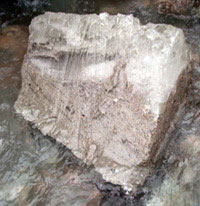|
Gas leak?Antarctic ice may hide vast reservoir of methane in sedimentary basinsPosted September 7, 2012
A new study by an international team of scientists in the Aug. 30 issue of the prestigious journal Nature suggests that Antarctica could be an overlooked but important source of methane, a potent greenhouse gas. The new study suggests that old organic matter in sedimentary basins located beneath Antarctica’s ice sheets may have been converted to methane by microorganisms living under oxygen-deprived conditions. The methane could be released to the atmosphere if the ice sheet shrinks and exposes these old sedimentary basins. “It is easy to forget that before 35 million years ago, when the current period of Antarctic glaciations started, this continent was teeming with life," said study co-author Slawek Tulaczyk “Some of the organic material produced by this life became trapped in sediments, which then were cut off from the rest of the world when the ice sheet grew,” explained Tulaczyk, whose work is supported by the National Science Foundation Tulaczyk is also a principal investigator on an upcoming project to access a subglacial lake and water system called WISSARD The researchers estimated that 50 percent of the West Antarctic Ice Sheet and 25 percent of the East Antarctic Ice Sheet overlies pre-glacial sedimentary basins containing about 21,000 billion metric tons of organic carbon. “This is an immense amount of organic carbon, more than ten times the size of carbon stocks in northern permafrost regions,” said lead author Jemma Wadham The researchers numerically simulated the accumulation of methane in Antarctic sedimentary basins using an established one-dimensional hydrate model. They found that subglacial conditions favor the accumulation of methane hydrate, which is methane trapped within a structure of water molecules, forming a solid similar to regular ice. They also calculated that the potential amount of subglacial methane hydrate and free methane gas could be up to four billion metric tons, a similar order of magnitude to some estimates made for Arctic permafrost. The predicted shallow depth of these potential reserves also makes them more susceptible to climate forcing than other methane hydrate reserves on Earth. Potential methane release during episodes of ice-sheet collapse could act as a positive feedback on global climate change during past and future ice-sheet retreat. “Our study highlights the need for continued scientific exploration of remote sub-ice environments in Antarctica, because they may have far greater impact on Earth’s climate system than we have appreciated in the past,” Tulaczyk said. |



For USAP Participants |
For The Public |
For Researchers and EducatorsContact UsU.S. National Science FoundationOffice of Polar Programs Geosciences Directorate 2415 Eisenhower Avenue, Suite W7100 Alexandria, VA 22314 Sign up for the NSF Office of Polar Programs newsletter and events. Feedback Form |




